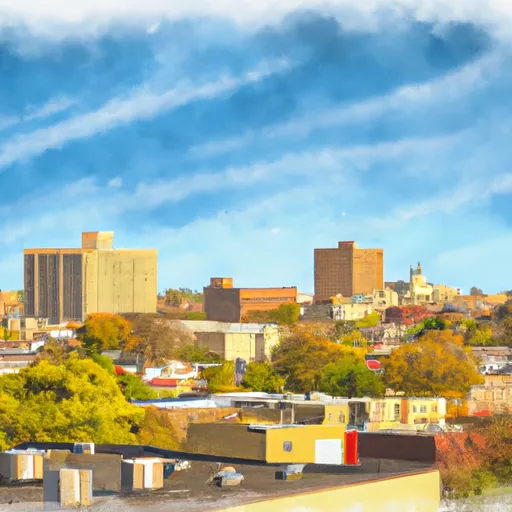-
 Snoflo Premium
Snoflo Premium
Get unlimited access to all our content
With no Ad interruptions! - Start Your Free Trial Login with existing account
West-Lafayette
Eden Index
Climate
8.0
•
Recreation
3.4
•
Community
3.7
•
Safeguard
5.3/10

West Lafayette, Indiana is a vibrant city located in Tippecanoe County. The climate in West Lafayette is characterized by hot and humid summers, with temperatures averaging around 85°F (29°C), and cold winters, with temperatures dropping to an average of 30°F (-1°C). The city experiences moderate rainfall throughout the year, with the wettest months being May and June.
The hydrology constituents in West Lafayette are mainly influenced by the Wabash River, which flows through the city. The river provides opportunities for recreational activities such as kayaking, canoeing, and fishing. The Celery Bog Nature Area is another notable hydrological feature, offering peaceful walking trails and a beautiful lake for birdwatching and nature observation.
Outdoor recreation opportunities in West Lafayette extend beyond hydrology. The city boasts numerous parks and green spaces, including Happy Hollow Park, where visitors can enjoy picnicking, hiking, and playing sports. The Wabash Heritage Trail is a scenic pathway perfect for walking, running, or biking, while the Prophetstown State Park offers camping, wildlife viewing, and horseback riding.
Overall, West Lafayette offers a diverse range of outdoor activities, from water-based adventures to serene nature exploration, making it an ideal destination for nature enthusiasts and outdoor lovers.
What is the Eden Index?
The Snoflo Eden Index serves as a comprehensive rating system for regions, evaluating their desirability through a holistic assessment of climate health, outdoor recreation opportunities, and natural disaster risk, acknowledging the profound impact of these factors on livability and well-being.
Climate Health Indicator (CHI): 8.0
West-Lafayette receives approximately
958mm of rain per year,
with humidity levels near 81%
and air temperatures averaging around
11°C.
West-Lafayette has a plant hardyness factor of
5, meaning
plants and agriculture in this region thrive during a short period during spring and early summer. Most
plants will die off during the colder winter months.
By considering the ideal temperature range, reliable water supplies, clean air, and stable seasonal rain or snowpacks, the Climate Health Indicator (CHI) underscores the significance of a healthy climate as the foundation for quality living.
A healthy climate is paramount for ensuring a high quality of life and livability in a region, fostering both physical well-being and environmental harmony. This can be characterized by ideal temperatures, reliable access to water supplies, clean air, and consistent seasonal rain or snowpacks.
Weather Forecast
Streamflow Conditions
Wabash
Area Rivers
Wabash
Snowpack Depths
Wabash
Reservoir Storage Capacity
Wabash
Groundwater Levels
Recreational Opportunity Index (ROI): 3.4
The Recreational Opportunity Index (ROI) recognizes the value of outdoor recreational options, such as parks, hiking trails, camping sites, and fishing spots, while acknowledging that climate plays a pivotal role in ensuring the comfort and consistency of these experiences.
Access to outdoor recreational opportunities, encompassing activities such as parks, hiking, camping, and fishing, is crucial for overall well-being, and the climate plays a pivotal role in enabling and enhancing these experiences, ensuring that individuals can engage in nature-based activities comfortably and consistently.
Camping Areas
| Campground | Campsites | Reservations | Toilets | Showers | Elevation |
|---|---|---|---|---|---|
| Lincoln State Park | 270 | 467 ft | |||
| Ferdinand State Forest | 70 | 489 ft | |||
| West Boggs Park | 220 | 528 ft | |||
| Dubois County Park | 32 | 575 ft | |||
| Glendale State Fish and Wildlife Area | 120 | 495 ft | |||
| Montgomery Rec Park | None | 515 ft | |||
| Vastwood Co Park | 21 | 490 ft | |||
| Martin State Forest | 25 | 743 ft | |||
| Crane MWR Military | None | 594 ft | |||
| Sunset City Park | None | 548 ft |
Nearby Fishing
Nearby Ski Areas
Catastrophe Safeguard Index (CSI):
The Catastrophe Safeguard Index (CSI) recognizes that natural disaster risk, encompassing floods, fires, hurricanes, and tornadoes, can drastically affect safety and the overall appeal of an area.
The level of natural disaster risk in a region significantly affects safety and the overall livability, with climate change amplifying these risks by potentially increasing the frequency and intensity of events like floods, fires, hurricanes, and tornadoes, thereby posing substantial challenges to community resilience and well-being.
Community Resilience Indicator (CRI): 3.7
The Community Resilience Indicator (CRI) recognizes that education, healthcare, and socioeconomics are crucial to the well-being of a region. The CRI acknowledges the profound impact of these elements on residents' overall quality of life. By evaluating educational resources, healthcare accessibility, and economic inclusivity, the index captures the essential aspects that contribute to a thriving community, fostering resident satisfaction, equity, and social cohesion.

